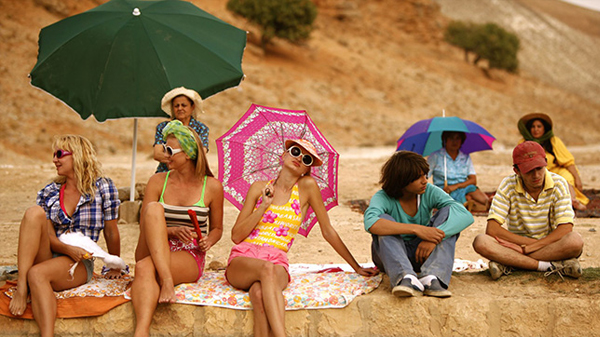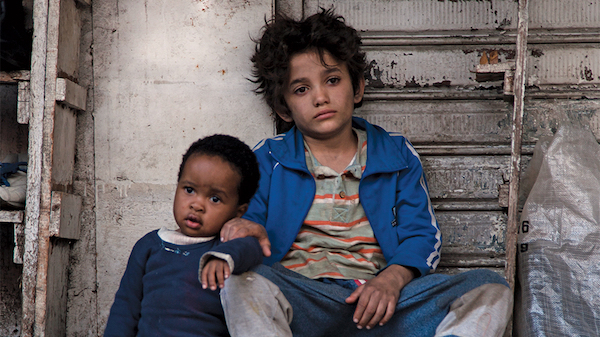READ ME is a platform for female-led writing on film hosted by Girls on Tops. Louisa Maycock (@louisamaycock) is Commissioning Editor and Ella Kemp (@efekemp) is Contributing Editor.
Lebanese filmmaker Nadine Labaki sheds light on the forgotten voices in the face of abject suffering. Cathy Brennan revisits the director’s first two films to establish how she spotlights the children who are always watching.
“If those children could talk, or could express themselves, what would they say? What would they tell us, this society that ignores them?”- Nadine Labaki
This is the question that preoccupies Nadine Labaki in her latest film, Capernaum. The story focuses on Zain, “a modern-day Lebanese answer to the stock Charles Dickens street urchin”, who sues his parents for giving him life. It is the culmination of a mounting anxiety in the Lebanese director's work, where she uses a child's perspective to interrogate the entrenched social ills of society.
We can see the early growth of this preoccupation with children in her 2006 debut Caramel, focusing on five women whose lives are linked by a beauty salon. One of the women, Nisrine, is on the cusp of married life. Her fiancé Bassam, a handsome man who is referred to as “Prince Charming”, tells her on the way to meet his family for dinner that she would “look better without the chewing gum”. This quiet moment cuts straight to the raucous end of the meal, where female relatives argue over who should clean up while Nisrine and the men remain seated. On the surface, Nisrine's discomfort is expected since she is surrounded by in-laws, at which point Labaki complicates the scene by giving us another view from under the dinner table – a shot of Bassam's hand wandering up Nisrine's dress. Her own hands bat it away, and he whispers “no one can see us”, though surely he would “look better” without groping his fiancée. Labaki then adds another layer to the scene, by revealing a little boy hiding under the table. He sees but he does not understand, and so follows Bassam's example by trying to put his head under Nisrine's dress, as she tries to make small talk with Bassam's father.
The scene is played for awkward laughs, yet Labaki makes a compelling point about how inappropriate, sexist behaviour is unwittingly passed on from one generation to the next. Labaki shows a close-up of Bassam's groping hand before revealing that it is from the child's perspective. It only lasts a minute, and yet Labaki skilfully weaves together multiple perspectives along gendered and generational lines to make a broader social point about how toxic behaviours persist through the years – because children are always watching.
In her 2011 follow-up feature Where Do We Go Now?, Labaki tells the story of an unnamed village that is threatened by escalating sectarian violence between Christian and Muslim men. This somewhat reflects the religious tensions behind the Lebanese Civil War that coloured Labaki’s own childhood, although she admits the film avoids historical specificity to tell a “more universal” story. In response to the men’s belligerence, the women of the village (led by cafe owner Amal, played by Labaki herself) band together in secret and attempt to bring about peace through elaborate schemes from faking miracles, to hiring Ukrainian strippers. The film is musical and often comedic, however the frequent glimpses at photographs of dead sons remind the audience that Labaki’s intent is serious. It’s personal too, as Labaki was inspired to make the film following the upsurge of violence in Beirut in May 2008, coinciding with the realisation that she was pregnant.
Labaki establishes these grave consequences early on, through a scene of shocking violence against a child. In retaliation for filling a mosque with goats, an unknown perpetrator fills the church font with chicken blood. As the congregation exits the church and realises what has happened, Isaam, a temperamental man sees fleeing Muslim children, including a boy on crutches. He trips the boy up and threatens to kill him in a pathetic display. Labaki depicts this moment in a ground-level long shot, putting the audience in the position of a bystander rather than that of an omnipotent observer, thereby implicating them in the ethics of witnessing. Issam towers over the boy who lies helpless on the ground. Labaki never reveals the identity of the culprit who desecrated the font, further demonstrating how Issam’s rage is fuelled by prejudice rather than by reason. Mothers, both Christian and Muslim, attempt to defuse the situation while the men stare on.
Such incidents in the village reach their nadir when a brawl between the men erupts inside Amal's cafe. It's a depressing scene that begins with a Year 8-worthy “your mum” diss. The camera frames the fight not as a clearly demarcated stand-off but as a blob of flailing bodies, while Amal watches on in horror. The soundtrack drowns out the continuing shouts as the mournful score takes over, signalling an eruption of emotion that transcends language. As with the dinner scene in Caramel, Labaki gives texture to this scene by offering a child’s eye view of this male noise; that of a boy who looks no more than five years old. Rather than hide the child's perspective as she did in Caramel, Labaki makes him a visible character from the start of the cafe scene, prioritising his perspective over the other characters. The scene ends with a distraught Amal kicking the men out of the cafe, and while she weeps, the little boy checks to make sure the door is closed.
In both Caramel and Where Do We Go Now?, the little boys are mostly passive observers. While the scene in Caramel is fleeting, in Where Do We Go Now? Labaki becomes increasingly conscious of how children inevitably become entangled in the affairs of adults. Although Amal is one of the protagonists in the Where Do We Go Now?, Labaki makes the boy's mini-arc central to the entire scene. The ever-silent child is impossible to ignore, even when he is in the background of crowded shots, in no small part due to his sky-blue shirt. Where Caramel is filled with a worry that little boys are doomed to repeat the sins of older men, Where Do We Go Now? is somewhat more ambivalent. It is difficult to gauge the child’s emotions. His wide-eyed expression in the face of violence could be read as trauma or fascination, while his muteness throughout the scene leaves a blank. It would be easy to recognise terror if he were crying, but that silence gives space for us to project other emotions. That uncertainty plays into the title of the film and the opening quotation from Labaki: “where do we go now?”; “what would they say?” At this point Labaki did not have an answer. She had conceived the idea of the film while pregnant with her son, when parenthood was still a prospect. In a 2012 interview with the New Yorker, after giving birth to her son, she describes her role as a mother and worries that the prospect of a fight is “always tempting especially for young men”.
Now, with Zain in Capernaum, Labaki gives children a voice to comment on how adult conflicts impact children’s lives. Between the releases of Where Do We Go Now? and Capernaum, worldwide events have emphasized the increasingly apathetic response to the suffering of children. From the deaths of refugees like Alan Kurdi, or the inhumanity of detention camps filled with children, these images of abject suffering can reduce their subjects to voiceless victims. After two films featuring mute, unnamed boys in the background, Labaki is ready to put them at the forefront and let them speak on what they see.
Cathy Brennan (@TownTattle) is a freelance film critic based in Edinburgh.




